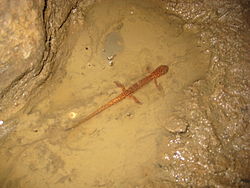| Big Bone Cave | |
|---|---|
 Civil-war era saltpeter vat in Big Bone Cave Civil-war era saltpeter vat in Big Bone Cave | |
| Location | Van Buren County, Tennessee, United States |
| Length | 9.627 m (15.494 km) |
| Discovery | c. 1810 |
| Geology | Monteagle Limestone |
| Entrances | 2 |
| List of entrances | Main Entrance (collapsed), Arch Cave Entrance |
| Hazards | histoplasmosis |
| Access | restricted |
| Website | TDEC: Big Bone Cave |
| Big Bone Cave | |
| U.S. National Register of Historic Places | |
 | |
| Location | Van Buren County, Tennessee, United States |
| Nearest city | Bone Cave, Tennessee |
| Coordinates | 35°46′21″N 85°33′25″W / 35.7726°N 85.557°W / 35.7726; -85.557 |
| Area | 400 acres (160 ha) |
| NRHP reference No. | 73001853 |
| Added to NRHP | April 11, 1973 |

(Big) Bone Cave is a cave located in Van Buren County, Tennessee, in the community of Bone Cave that is named after it. It is notable both for its history and current recreational use. It is listed on the National Register of Historic Places and a designated National Natural Landmark. It is a 400-acre (161.9 ha) State Natural Area managed by Rock Island State Park. It is named for the discovery of the bones of a giant ground sloth in 1811. The cave was operated as a saltpeter mine, notably during the War of 1812 and the American Civil War. A variety of natural remains and human artifacts have been well preserved in the dry atmosphere of the cave. The cave is the 10th longest mapped cave in Tennessee.
Big Bone Cave formed in Mississippian Montegeale limestone originally on the western escarpment of the Cumberland Plateau. The cave formed prior to 5.7 ±1.09 Ma based in cosmogenic radionuclide dating of pebbles washed into the Muster Ground room. Long passages formed during a long period of water table stability when the climate was warmer and sea levels were higher reducing erosion throughout the Mississippi drainage. At the time, the Cumberland River flowed across the Highland Rim before the formation of the Nashville Basin. Global cooling 3.2-3.1 Ma triggered a 75–100-metre (246–328 ft) sea-level drop which increased erosion (incision) up the Mississippi River and led to the Cumberland River cutting into the Highland Rim and its headwaters, the Collins River, cutting into the Cumberland Plateau. The lower water table would have drained the water filling the caverns. Further erosion isolated Bone Cave Mountain from the Cumberland Plateau.
Notes
- Miller, Larry L. (2001). Tennessee Place-names. Indiana University Press. p. 26. ISBN 0-253-21478-5.
- "National Natural Landmarks - National Natural Landmarks (U.S. National Park Service)". www.nps.gov. Retrieved March 25, 2019.
Year designated: 1973
- "Big Bone Cave Class II Natural-Scientific State Natural Area". Tennessee Department of Environment and Conservation.
- Gulden, Bob (November 28, 2016). "USA LONGEST CAVES". NSS Geo2 Long & Deep Caves. Archived from the original on April 21, 2006. Retrieved May 29, 2017.
- Anthony, Darlene M.; Granger, Darryl E. (August 2004). "A Late Tertiary origin for multilevel caves along the western escarpment of the Cumberland Plateau, Tennessee and Kentucky, established by cosmogenic
Al
and
Be
" (PDF). Journal of Cave and Karst Studies. 66 (2): 46–55. ISSN 1090-6924. Retrieved May 29, 2017. - Shackleton, N.J.; Backman, J.; Zimmerman, H.; Kent, D.V.; Hall, M.A.; Roberts, David G.; Schnitker, D.; Baldauf, J.G.; Desprairies, A.; Homrighausen, R.; Huddlestun, P.; Keene, J.B.; Kaltenback, A.J.; Krumsiek, K.A.O.; Morton, A.C.; Murray, J.W.; Westberg-Smith, J. (February 16, 1984). "Oxygen isotope calibration of the onset of ice-rafting and history of glaciation in the North Atlantic region". Nature. 307 (5952): 620–623. Bibcode:1984Natur.307..620S. doi:10.1038/307620a0. S2CID 4344673.
Further reading
- Smyre, John L. and Zawislak, Ronald L., Big Bone and the Caves of Bone Cave Mountain, (2007) Rocky River Press, Rock Island Tennessee, ISBN 978-0-9779471-0-2, ISBN 0-9779471-0-6.
- Matthews, Larry E. Big Bone Cave, (2006) National Speleological Society, ISBN 1-879961-24-5.
- Barr, Thomas C. Jr., Caves Of Tennessee, (1961) Bulletin 64 of the Tennessee Division of Geology, See pages 451–460.
External links
| Pre-Columbian North America | |
|---|---|
| Archaeological cultures |
|
| Archaeological sites |
|
| Human remains | |
| Miscellaneous |
|
| |
- Archaeological sites on the National Register of Historic Places in Tennessee
- Caves of Tennessee
- Wild caves
- National Natural Landmarks in Tennessee
- State parks of Tennessee
- Protected areas of Van Buren County, Tennessee
- Landforms of Van Buren County, Tennessee
- National Register of Historic Places in Van Buren County, Tennessee
- Mines in Tennessee
- Limestone caves